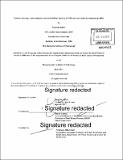| dc.contributor.advisor | David Geltner. | en_US |
| dc.contributor.author | Jalori, Saurabh | en_US |
| dc.contributor.other | Massachusetts Institute of Technology. Center for Real Estate. Program in Real Estate Development. | en_US |
| dc.date.accessioned | 2017-12-05T19:12:02Z | |
| dc.date.available | 2017-12-05T19:12:02Z | |
| dc.date.copyright | 2017 | en_US |
| dc.date.issued | 2017 | en_US |
| dc.identifier.uri | http://hdl.handle.net/1721.1/112420 | |
| dc.description | Thesis: S.M. in Real Estate Development, Massachusetts Institute of Technology, Program in Real Estate Development in conjunction with the Center for Real Estate, 2017. | en_US |
| dc.description | Cataloged from PDF version of thesis. | en_US |
| dc.description.abstract | The ever evolving macro and microeconomic environment makes real estate developers evaluate their development strategies. They do so in order to generate a maximum present value of profits from their projects. More importantly, they want to avoid completing the projects in an unfavorable environment and missing the financial targets. As the complexity in the production of a real estate project increases, orchestrating the various parts becomes even more important in reaching the desired financial outcomes. Hence, phasing plays an important role as it brings the flexibility to break the whole project into various parts or phases, which could function as standalone entities with or without other parts or phases. And so, it is important to consider how to delineate the project components between the various phases to achieve maximum profitability? The model developed here provides a framework for users to arrive at an optimal phasing scheme for their proposed projects. It is a transparent, easy to use model, which can help a user understand the value generating parameters while evaluating various schemes. It helps one conduct a deterministic analysis, i.e. without uncertainty, to explain the impact of four different parameters - project production profile and duration, real estate cycle periods and phases - on the phasing flexibility of a project. Eventually, a user can run probabilistic analysis including uncertainty in the real estate cycles and phases to determine an optimal phasing. The output from the deterministic analysis combines large amounts of data in a graphical array bringing clarity in phasing decisions. Finally, the probabilistic analysis combines information from the deterministic analysis helping the user arrive at the optimal phasing. | en_US |
| dc.description.statementofresponsibility | by Saurabh Jalori. | en_US |
| dc.format.extent | 19 pages | en_US |
| dc.language.iso | eng | en_US |
| dc.publisher | Massachusetts Institute of Technology | en_US |
| dc.relation.requires | CDROM contains an Excel file of supplemental data model. | en_US |
| dc.rights | MIT theses are protected by copyright. They may be viewed, downloaded, or printed from this source but further reproduction or distribution in any format is prohibited without written permission. | en_US |
| dc.rights.uri | http://dspace.mit.edu/handle/1721.1/7582 | en_US |
| dc.subject | Center for Real Estate. Program in Real Estate Development. | en_US |
| dc.title | Optimal phasing : a deterministic and probabilistic analysis of different real estate development profiles | en_US |
| dc.title.alternative | Deterministic and probabilistic analysis of different real estate development profiles | en_US |
| dc.type | Thesis | en_US |
| dc.description.degree | S.M. in Real Estate Development | en_US |
| dc.contributor.department | Massachusetts Institute of Technology. Center for Real Estate. Program in Real Estate Development. | en_US |
| dc.contributor.department | Massachusetts Institute of Technology. Center for Real Estate | |
| dc.identifier.oclc | 1008582118 | en_US |
